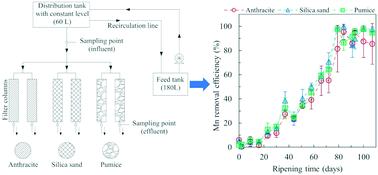当前位置:
X-MOL 学术
›
Environ. Sci.: Water Res. Technol.
›
论文详情
Our official English website, www.x-mol.net, welcomes your
feedback! (Note: you will need to create a separate account there.)
Start-up of bench-scale biofilters for manganese removal under tropical conditions: a comparative study using virgin pumice, silica sand, and anthracite filter media
Environmental Science: Water Research & Technology ( IF 3.5 ) Pub Date : 2021-6-3 , DOI: 10.1039/d1ew00093d José A. Araya-Obando 1 , Luuk C. Rietveld 2 , Andrea Quesada-González 3 , Andrey Caballero-Chavarría 3 , Virginia Pacini 4 , Luis G. Romero-Esquivel 3
Environmental Science: Water Research & Technology ( IF 3.5 ) Pub Date : 2021-6-3 , DOI: 10.1039/d1ew00093d José A. Araya-Obando 1 , Luuk C. Rietveld 2 , Andrea Quesada-González 3 , Andrey Caballero-Chavarría 3 , Virginia Pacini 4 , Luis G. Romero-Esquivel 3
Affiliation

|
Biofiltration for Mn removal has not been proven in the tropics (18–29 °C). Also, the use of pumice as an alternative filter medium for Mn removal is still poorly known. In this study, a bench-scale biofiltration experiment, using virgin pumice, silica sand, and anthracite, was conducted for 107 days using tropical groundwater at 22 °C. Characterization of manganese oxide (MnOx) on filter media was carried out by Raman spectroscopy, X-ray diffraction (XRD), and scanning electron microscopy (SEM). The ability of culturable bacteria to oxidize Mn was verified by the leucoberbelin blue dye assay (LBB). The microbial activity on filter media was studied by ATP analyses. Identification of the MOB was performed by 16S rRNA sequencing. Results showed that the ripening time in each column was similar (∼80 days); therefore, the filter media and water temperature do not seem to accelerate the start-up period. The MnOx present on all ripened media was of the birnessite type. The MnOx morphology, influent water parameters, and microbiological activity suggest a start-up period likely assisted by biological oxidation. Therefore, biofiltration for manganese removal is feasible under tropical conditions. The similarity in the performance of pumice with the other media confirmed its suitability for biotic Mn removal. All materials presented similar known MOB at the genus level; however, different closest related species colonized selectively the filter media. Two strains of Pseudoxanthomonas sp., a not recognized genus on matured biofilters, look promising as inoculums in pumice and sand. Proper application of biofiltration in the tropics needs operational and bioaugmentation strategies.
中文翻译:

在热带条件下启动用于去除锰的实验室规模生物过滤器:使用原始浮石、硅砂和无烟煤过滤介质的比较研究
用于去除锰的生物过滤尚未在热带地区(18-29 °C)得到证实。此外,使用浮石作为去除锰的替代过滤介质仍然鲜为人知。在这项研究中,使用原始浮石、硅砂和无烟煤,使用 22 °C 的热带地下水进行了 107 天的实验室规模生物过滤实验。氧化锰的表征 (MnO x) 通过拉曼光谱、X 射线衍射 (XRD) 和扫描电子显微镜 (SEM) 对过滤介质进行分析。可培养细菌氧化 Mn 的能力通过 leucoberbelin 蓝染料测定 (LBB) 进行了验证。通过ATP分析研究过滤介质上的微生物活性。MOB 的鉴定是通过 16S rRNA 测序进行的。结果表明,每列的成熟时间相似(~80 天);因此,过滤介质和水温似乎并没有加速启动期。存在于所有熟化介质上的 MnO x是水钠锰矿类型。MnO x形态、进水参数和微生物活动表明可能由生物氧化辅助的启动期。因此,用于去除锰的生物过滤在热带条件下是可行的。浮石性能与其他介质的相似性证实了其适用于生物锰去除。所有材料在属水平上都呈现出相似的已知 MOB;然而,不同的最亲缘物种选择性地定居在过滤介质中。两种Pseudoxanthomonas sp.菌株,一种在成熟生物过滤器上未被识别的属,看起来很有希望作为浮石和沙子中的接种物。在热带地区正确应用生物过滤需要操作和生物强化策略。
更新日期:2021-06-23
中文翻译:

在热带条件下启动用于去除锰的实验室规模生物过滤器:使用原始浮石、硅砂和无烟煤过滤介质的比较研究
用于去除锰的生物过滤尚未在热带地区(18-29 °C)得到证实。此外,使用浮石作为去除锰的替代过滤介质仍然鲜为人知。在这项研究中,使用原始浮石、硅砂和无烟煤,使用 22 °C 的热带地下水进行了 107 天的实验室规模生物过滤实验。氧化锰的表征 (MnO x) 通过拉曼光谱、X 射线衍射 (XRD) 和扫描电子显微镜 (SEM) 对过滤介质进行分析。可培养细菌氧化 Mn 的能力通过 leucoberbelin 蓝染料测定 (LBB) 进行了验证。通过ATP分析研究过滤介质上的微生物活性。MOB 的鉴定是通过 16S rRNA 测序进行的。结果表明,每列的成熟时间相似(~80 天);因此,过滤介质和水温似乎并没有加速启动期。存在于所有熟化介质上的 MnO x是水钠锰矿类型。MnO x形态、进水参数和微生物活动表明可能由生物氧化辅助的启动期。因此,用于去除锰的生物过滤在热带条件下是可行的。浮石性能与其他介质的相似性证实了其适用于生物锰去除。所有材料在属水平上都呈现出相似的已知 MOB;然而,不同的最亲缘物种选择性地定居在过滤介质中。两种Pseudoxanthomonas sp.菌株,一种在成熟生物过滤器上未被识别的属,看起来很有希望作为浮石和沙子中的接种物。在热带地区正确应用生物过滤需要操作和生物强化策略。









































 京公网安备 11010802027423号
京公网安备 11010802027423号